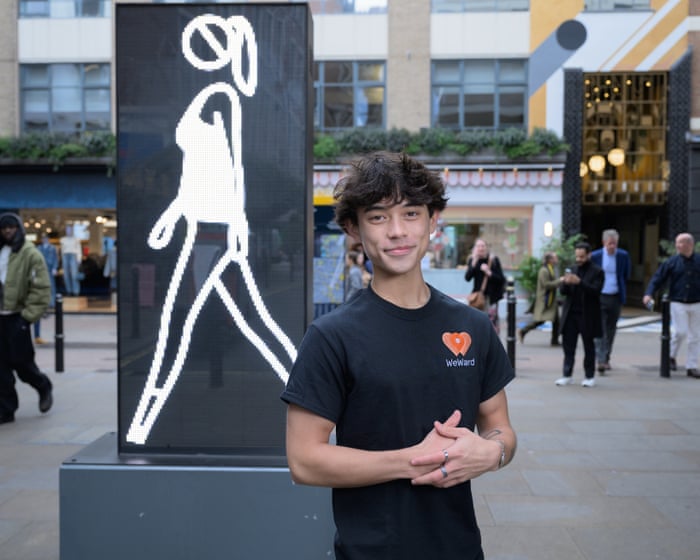It’s a damp, grey morning in Soho, London, and Cameron Roh is standing about a meter behind a woman who is speaking loudly into her phone outside Caffè Nero. She is breaking his “laws” of “pavement etiquette,” so he holds up his phone and presses record. Lost in conversation, the woman doesn’t notice him, but even from a distance, watching him is cringe-worthy. What if she turns around? Is this allowed? Is it even okay?
Suddenly, the woman hangs up and dashes across the road, unaware of what just happened. With the evidence captured, Roh returns to where I’m hiding and gives his verdict, rating her out of 10—with 10 being perfect pavement etiquette. “That’s a two,” he says. Her crimes? “On her phone, sudden stop, right in the middle of the pavement, forcing people to walk around her. No, no, no.” She didn’t see us, but that somehow feels worse; I feel like we’ve just pickpocketed her. Roh giggles, unfazed. As a self-appointed pavement vigilante, this is what he does.
Roh, who is 21, posted his first video in July. In about 20 seconds, he follows five different walkers, quietly analyzing their gait on camera before rating them on speed, direction, footwork, and phone use. Since then, he has rated walkers in New York in over 30 videos and has recently expanded to other US cities. This is his first time experiencing the specific chaos of central London. “So far, it seems comparable to New York,” he says. Just then, a Lime bike almost collides with us outside a cinema. “Come on!” he exclaims. “Those city bikes are a new thing. That’s an automatic zero, buddy.”
Roh says he tries to ensure no one is identifiable in his videos and has strict rules about who is off-limits for criticism—young children, groups of children, people with disabilities, and the elderly, though how he determines if someone is less able is unclear. At one point, we watch a small woman, who I’d guess is in her early 60s, pushing a Brompton bike and navigating through a school group while on her phone. Roh decides against filming her, even though she’s breaking almost all of his rules. “I focus on people who actively choose to be inconsiderate,” he says. And it’s not just because they bother other pavement users; “They are also safety hazards.” The woman with the Brompton is “fast and clearly has somewhere to be.”
Rather than assuming there’s a right way to walk, Roh believes everyone simply has the right to walk. Yet, whether it’s manspreading on buses or queue-jumping, frustration with poor public behavior is not only common but a cornerstone of British humor. That said, while having strong opinions on how things should be done is a very British pastime, getting angry about it in public isn’t our style. “Rage only ever applies to traffic—it’s the same in New York,” says Roh. “The thing is, no one screams at anyone for walking badly, but we all feel it.”
Pavement etiquette is “getting worse,” he says, partly due to smartphones. He pauses to point out how many people around us are walking while staring at their phones. “I call these people neck breakers,” he says. “People stuck at a 45-degree angle on their phones, not with us in reality.”
When judging walkers, the first thing Roh looks at is speed. “If you’re walking badly—not in a straight line or dragging something—but your pace is adequate, then you’re probably not affecting my journey,” he says. Then it’s placement. “If you’re zigzagging, aimlessly cutting people off, not paying attention to your surroundings, that’s…”You’ll automatically lose a few points for certain behaviors. Among these, there are some subcategories that might seem both new and familiar—like Lime bikes riding on pavements, people staring at their phones, scooters on pavements, charity fundraisers, small wheelie suitcases that should be carried, and individuals too busy eating on the move to watch where they’re going. Then there are those who walk straight into you, as Roh mentions while we step aside to avoid one. “If you’re checking your map, just pull over,” he mutters to a group of women tapping on a screen.
Roh has a list of walking offenses that form the basis of his system. The woman outside Caffè Nero, for example, committed a “brake check” by stopping suddenly without checking if anyone was behind her. “Whoomp! Hard stop. Right in front of you, no blind spot check,” he explains.
A particular annoyance for him is people walking side by side—”double wides,” “triple wides,” or “linked double wides,” where a couple is connected, making it difficult to pass. When asked about the largest group he’s encountered, he sighs and shakes his head, recalling a “linked quadruple-wide.”
Of course, Roh isn’t the first to get worked up about this. It’s a theme popularized by writer Fran Lebowitz, known for her sharp observations on public behavior. Roh shrugs at her name and makes a mental note to look her up later.
As we navigate around a cluster of men blocking the pavement, he mutters that they should “leave space for those of us with places to be.” But his frustration runs deeper: he believes cities are increasingly designed for vehicles over people. Pavements are narrow, poorly maintained compared to roads, and sometimes merge into traffic without warning. Walking in cities, while a great equalizer, can be disorienting and hazardous, turning a peaceful stroll into a chaotic, hurried dash. “These places aren’t for people, even though they are,” he reflects. Ultimately, it’s about rushing from point A to B—or perhaps capitalism, as Colson Whitehead wrote, with everyone feeling their day is harder than others’.
As part of Generation Z, Roh has always been immersed in social media. Growing up in Ohio, he first experienced “hallway rage” in high school, frustrated by people loitering in corridors. “I’m going to be late because of you? No way, that’s got to stop,” he says. “I’ve always been a fast walker, always knowing where I’m headed.”
After moving to New York for its opportunities, he was taken aback by how people navigated the crowded streets. He joined the ranks of those turning TikTok and Instagram into a profitable venture by filming these interactions.
Despite his concerns about smartphones, Roh acknowledges the irony that his work is filmed and shared through screens. “The world is so disconnected,” he observes. “We’re all consumed by our phones and AirPods. It’s not just younger generations; it’s everyone now. But for me, this work is a way to get outside and walk with purpose.”
So far, Roh’s videos have…His videos have amassed 10 million views and inspired imitators, which he attributes to capturing “a universal feeling.” He prefers to carry out his sidewalk monitoring early in the morning. “I’m more forgiving later in the day,” he explains, because people are usually less hurried. The clips are both amusing and irritable, showcasing small acts of civil protest as they happen. A man approaches us, pulling a suitcase while staring at his phone. “He’s doing his best,” Roh comments. “He’s moving quickly, but he’s taking up a lot of room. You know about manspreading? This is like man-walking.”
The Metropolitan Police confirm that no permit is required to film in public spaces, and the individuals Roh records are mostly unidentifiable, filmed from behind. Still, does he ever feel guilty about his actions? “Not really. Most responses are thanks—people think I’m helping tidy up the city.” So, like Batman? “Exactly. We need more of this—more people doing it, and then everyone will walk better.”
I suggest to Roh that there should be space for leisurely strolling. What about the 19th-century flâneur, who wandered without purpose, observing without engaging—a balance between idleness and activity, as Edmund White described? “The what? No. Just go to a park,” he replies. He adds that when you see people meandering slowly, blissfully unaware, “it kind of makes you jealous, doesn’t it?”
Later that day, as I hurry to collect my children, my way is blocked by a relaxed young couple ambling along. Hearing me huff with impatience, the man instinctively moves aside—but too late, I’ve already stepped into the road to skirt around them. I mentally note: linked double wide, one point out of ten for the acknowledgment. Deep down, we’re all sidewalk vigilantes; we just don’t have Roh’s way with words.
Frequently Asked Questions
Of course Here is a list of FAQs about Cameron Rohs pavement vigilante campaign designed with clear questions and direct answers
Beginner Definition Questions
1 Who is Cameron Roh and what is a pavement vigilante
Cameron Roh is a Londonbased pedestrian who started a social media campaign A pavement vigilante is his term for someone who politely points out when peoples behavior on the sidewalk is inconsiderate or dangerous to others
2 What is the main goal of his campaign
The main goal is to make sidewalks safer and more pleasant for everyone especially for people with disabilities the elderly and parents with strollers by encouraging more awareness and courtesy
3 What kind of behavior does he call out
He primarily calls out people who stop suddenly in the middle of a busy sidewalk walk in large groups that block the entire path or stare at their phones without paying attention to their surroundings
Benefits Motivation
4 Whats the benefit of this campaign
It raises public awareness about a common nuisance that many people silently endure It encourages people to think about how their actions affect the flow and safety of pedestrian traffic
5 Who benefits the most from this kind of activism
The most vulnerable pedestrians benefit the most including people who are blind or use wheelchairs for whom a blocked sidewalk isnt just an annoyanceits a significant barrier
6 Is this just about complaining or is there a positive side
While it highlights a problem the positive side is promoting a community mindset Its about reminding people that sidewalks are shared public spaces where a little consideration makes things better for everyone
Common Problems Criticisms
7 Isnt this just being a Karen or unnecessarily confrontational
Cameron Roh emphasizes being polite and nonconfrontational The idea isnt to shame people aggressively but to calmly make them aware of an issue they may not have noticed
8 Couldnt this be dangerous What if someone reacts badly
This is a valid concern Cameron always assesses the situation for safety and keeps his interactions brief and polite He does not recommend confronting anyone who appears aggressive
9 Is it legal to film people on the street for this
In the UK where he




